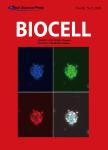Possible mechanisms of bidirectional nuclear transport during neuronal migration
作者机构:Graduate School of BiostudiesKyoto UniversityKyoto606-8501Japan Institute for Integrated Cell-Material Sciences(WPI-iCeMS)Kyoto UniversityKyoto606-8501Japan
出 版 物:《BIOCELL》 (生物细胞(英文))
年 卷 期:2022年第46卷第11期
页 面:2357-2361页
核心收录:
学科分类:0710[理学-生物学] 07[理学] 070202[理学-粒子物理与原子核物理] 0702[理学-物理学]
主 题:Nesprin-2 Nucleus Microtubules Kinesin Dynein
摘 要:Neuronal migration is a fundamental process of mammalian brain development.In migrating neurons,the nuclear membrane protein Nesprin-2 has been shown to serve as an adaptor to pull the nucleus along microtubule tracks.Current evidence has shown that Nesprin-2 binds to both the minus-end-directed motor dynein as well as the plus-end-directed motor kinesin.However,translocation of neuronal nucleus has long been thought to be primarily driven by dynein motors.Intriguing questions could be raised about the role of kinesin in nuclear transport and how the activities of opposing motors are coordinated through interactions with Nesprin.Combining evidence from recent studies,we propose that Nesprin-2 serves as a switchboard in mediating bidirectional neuronal nuclear movements.



